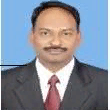
Makam Venkata Subramanyam
Work place: Santhi Ram Engineering College, Nandyal, Andhra Pradesh, India
E-mail: subramanyam.mv.1968@ieee.org
Website:
Research Interests: Engineering, Computational Engineering, Computational Science and Engineering
Biography
Dr.M.V.Subramanyam received Bachelor of Engineering degree in Electronics and Communication Engineering from Gulbarga University, Karnataka, India, master degree in Digital Systems and Computer Electronics from Jawaharlal Nehru Technological University, Hyderabad, Andhra Pradesh, India, in 1989 and 1998, respectively. Also, he received Ph.D. in Ad hoc Networks from Jawaharlal Nehru Technological University, Hyderabad, in 2007. He has more than 24 years of teaching experience and six years of research experience. He held different positions in his career like Head of the Department. At present, he is the Principal of Santhi Ram Engineering College, Nandyal, A.P, India. He produced 3 Ph.D. candidates. He is currently guiding more than 10 Research Scholars and also M.Tech Students. He published more than 100 technical papers in national and International journals and conferences. He is the referee/ editorial member of One National Journal and One International Journal. He authored 3 textbooks. He has membership in many professional societies like IEEE, IETE, ISTE, and IE (I). He received Patent for his research work in 2015.
Author Articles
Image Compression and Reconstruction using Discrete Rajan Transform Based Spectral Sparsing
By Kethepalli Mallikarjuna Kodati Satya Prasad Makam Venkata Subramanyam
DOI: https://doi.org/10.5815/ijigsp.2016.01.07, Pub. Date: 8 Jan. 2016
As a contribution from research conducted by many, various image compression techniques have been developed on the basis of transformation or decomposition algorithms. The compressibility of a signal is seen to be affected by the entropy in the signal. Compressibility is high if the energy distribution is concentrated in fewer coefficients. It is reasonable to expect that sparse signals have a highly compressible nature. Thus, sparse representations have potential uses in image compression techniques. There are many techniques used for this purpose. As an alternative to these traditional approaches, the use of Discrete Rajan Transform for sparsification and image compression was explored in this paper. The simulation results show that higher quality compression can be achieved for images using Discrete Rajan Transform in comparison with other popular transforms like Discrete Cosine Transform, and Discrete Wavelet Transform. The results of the experiment were analyzed on the basis of seven quality measurement parameters – Mean Squared Error, Peak Signal to Noise ratio, Normalized Cross-Correlation, Average Difference, Structural Content, Maximum Difference, and Normalized Absolute Error. It was observed that Discrete Rajan Transform is effective in introducing sparsity in images and thereby improving compressibility.
[...] Read more.Other Articles
Subscribe to receive issue release notifications and newsletters from MECS Press journals